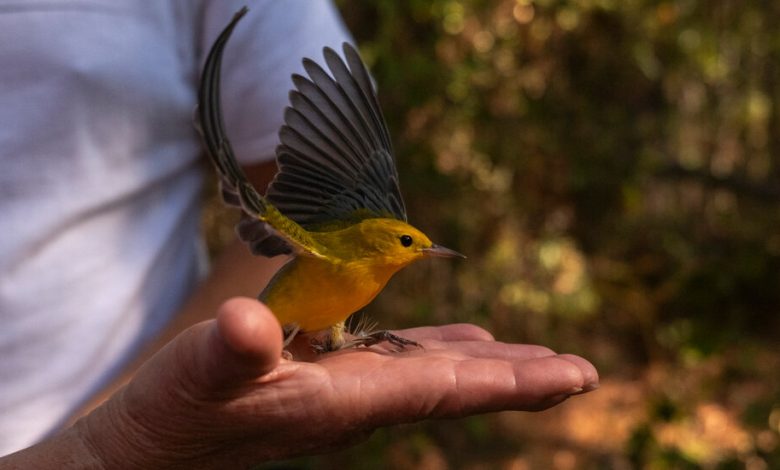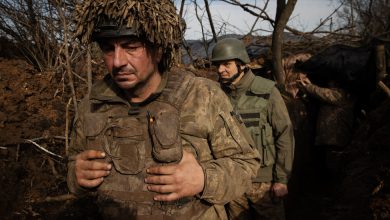9 Days, 527 Birds, 55 Species

On a map of the United States, you can barely see the skinny strip of land that is Fort Morgan, Ala. But the narrow peninsula — about 20 miles long and, in some places, less than a half-mile wide — is immensely important for migratory birds: It is the last land stop before they fly south across the Gulf of Mexico.
Recently, the Banding Coalition of the Americas spent nine days in the dense vegetation of Fort Morgan, carefully capturing birds in mist nets, fitting them with tiny leg bands and releasing them back into the world to make their long journey across the water.

Hannah Wright, left, a Banding Coalition of the Americas volunteer, and Emma Rhodes, a B.C.A. co-founder, cleared brush from trails before setting up passive mist nets to catch migratory birds.



Ms. Rhodes; volunteers setting up mist nets; Kyle Shepard, a B.C.A. co-founder.
By the end of the event, Emma Rhodes and Kyle Shepard, the co-founders of B.C.A., alongside a crew of 10 or so other trained and federally-licensed volunteers, had captured and banded 527 birds from 55 different species.
Seeing the birds up close and holding them in your hand can be transformative, said Ms. Rhodes, 28, an avian biologist and Ph.D. student at Auburn University. “It can really change people’s lives and give them new perspectives about why birds are important, why this habitat’s important, why this habitat shouldn’t just be condos,” she said.
Ms. Rhodes and Mr. Shepard were trained in bird banding at Fort Morgan as youngsters, when their mentors, Bob and Martha Sargent, led a nonprofit organization dedicated to the study and preservation of hummingbirds and other Neotropical migrants. The Sargents are now deceased, and in 2020, Ms. Rhodes and Mr. Shepard founded B.C.A. as a way of continuing the work.
Mr. Shepard, 30, began banding at Fort Morgan when he was 12 years old. When people are interested in volunteering, he said, “my first question is, well, how much time do you have to devote to it? Because it’s going to be the rest of your life — the training is never over.”



A hooded warbler; preparing to band a a ruby-throated hummingbird; a successfully banded hummingbird.
Still, Ms. Rhodes added, offering people the opportunity to volunteer was important to them both. “We had the advantage and the privilege of training at a very young age and really feeling like that changed our direction and our trajectory in life for the better,” Ms. Rhodes said.
The data collected by B.C.A. is reported to the Bird Banding Laboratory, a program run by the United States Geological Survey that, in collaboration with the Canadian Bird Banding Office, administers the North American Bird Banding Program.



Claudia Frosch, a volunteer, checking a mist net; Mr. Moore in a tangle; Kallie Moore, a 16-year-old volunteer, with a blue grosbeak before it was released.
Of course, birds know no borders. The species captured and released by B.C.A. are merely making a pit stop in Alabama. “A lot of times we’ll say, oh, North American species, but really they’re not North American species,” Ms. Rhodes said. “They’re all over the Americas and we’re sharing them.”
The team often finds some surprises in the nets. “This year we banded a Western tanager, which was not supposed to be there,” Ms. Rhodes said with a laugh; the bird’s typical habitat is farther west. She added, “We also banded two Western wood pewees” — again, not an eastern species.
The records collected by the B.C.A. will help scientists find larger trends. “We could be seeing a higher occurrence of western birds every year, and that’s something that needs to be documented,” Ms. Rhodes said.
Ultimately, she added, one of the organization’s goals is to share and exchange data with other regions: “Especially with people in the tropics, because you’ve got to understand the full annual cycle to conserve birds,” she said. “You can’t just study them in the winter.”
Ms. Rhodes said she also simply enjoyed seeing birds up close, even species that are common. Among her favorites is the male American redstart, nicknamed the Halloween bird for its black and orange feathers. She associates it with Fort Morgan, especially in the fall. “We banded a lot of them,” she said. They are important to the ecosystem, and to the work she has dedicated her life to, she said. But also: “They’re just pretty birds.”





